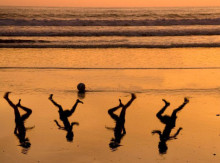War Resisters League – Southwest Campaigns: Kirtland AFB, Sandia and Los Alamos Laboratories
Military Occupation of New Mexico (map) courtesy of Swarthmore College Peace Collection
WRL Southwest formed as a chapter and then as a regional office in Albuquerque, New Mexico, during the Vietnam War. We wanted to be a voice for peace, pacifism and nonviolence in the area, which hosted the Kirtland Air Force Base and the two atomic weapons laboratories: Sandia in Albuquerque and Los Alamos National Laboratory in northern New Mexico, where the first nuclear weapons were researched and designed.
In May 1971 our protests were at Kirtland Air Force Base, and Bob Bady and I were arrested at the base entrance. Chuck Matthei, who was active with Peacemakers and the Community for Nonviolent Action at the time, came to visit us in jail and was arrested for resisting a police order. We worked with GIs at the base to resist the war, including a rally at which Tom Hayden spoke. The GI group published a newsletter called Special Weapon about research at the Kirtland Special Weapons Laboratories at the base.
We also worked against the Sandia National Weapons Lab and Manzano nuclear weapons storage facility. Manzano was the largest storage for nuclear weapons in the world (replaced in the 1990s by the Kirtland Underground Munitions and Maintenance Storage Complex). We held many protests at the base entrance, including Hiroshima and Nagasaki days, and brought many Japanese peace visitors to the Atomic Weapons Museum next to Sandia Labs.
At the Los Alamos Nuclear Weapons Labs, we had a three-day fast and vigil between August 6th and 9th in 1971. Bob Bady, Karin Rhodes, Geoff Beckett and I, among others, camped out in the town of Los Alamos and outside the weapons lab. The action got front page coverage in the local papers.
In the late 1970s the War Resisters League group with the help of members of the Albuquerque Friends Meeting formed the New Mexico Peace Conversion Project, which produced a map of New Mexico’s military and nuclear sites throughout the State. It was an amazing map that included uranium mines, waste disposal sites, and testing sites for nuclear weapons. It aided the work of the Mount Taylor Alliance of Indigenous, Chicano and environmental activists working to oppose uranium mining on the Navajo Reservation and the Waste Isolation Pilot Plant (WIPP) in Carlsbad, New Mexico, which, was chosen in 1973 for a radioactive waste storage site. WRL played a key role in training for a major civil disobedience action at the site. Twenty-six people were arrested, spending 8 to 10 days in jail.
 In May 1976, when WRL’s Continental Walk for Disarmament and Social Justice stopped in Albuquerque, WRL/Southwest organized a rally, picketing at Kirtland AFB, and a protest at Los Alamos, which also included walkers from Colorado.
In May 1976, when WRL’s Continental Walk for Disarmament and Social Justice stopped in Albuquerque, WRL/Southwest organized a rally, picketing at Kirtland AFB, and a protest at Los Alamos, which also included walkers from Colorado.
WRL played a role in the formation of the Cactus Alliance in 1977, connecting anti-nuclear groups from Arizona, Utah, Colorado and Texas, including those active against Amarillo’s nuclear bomb making Pantex Plant.
While we never managed to close the labs or the air base, WRL Southwest certainly exposed their horrific work to the people of New Mexico and helped lay the groundwork for the Albuquerque Peace and Justice Center, which is still active today, thanks to the work of Dorie Bunting (now 101 years old!), Kent Zook and many others.
 -Craig Simpson, former staff person for WRL-Southwest
-Craig Simpson, former staff person for WRL-Southwest
Share



